“The classic image of the Chandler noir detective is just a variation on the Cowboy” Stephan Franck talks 80s country noir in Palomino now funding on Kickstarter
We were huge fans of Stephan Franck’s excellent vampire thriller Silver, and so were delighted to learn he was producing a new crime noir thriller, Palomino. Set in 1980s LA and based around the infamous Palomino country music club, it’s a slice of hard boiled noir from the very top drawer (and perfect for fans of Criminal or Scalped). We caught up with Stpehan to find out more about it’s origins and motives.
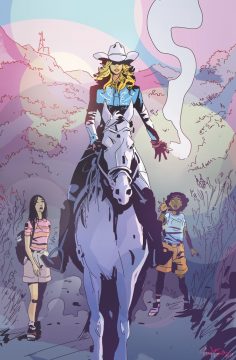 Your new book Palomino is a 80s set slice of LA Noir, what is it about that genre and setting that made you want to set your next story there? It’s quite a departure from the world of vampires in Silver?
Your new book Palomino is a 80s set slice of LA Noir, what is it about that genre and setting that made you want to set your next story there? It’s quite a departure from the world of vampires in Silver?
Stephan Franck: I have a lot of different project ideas in various stages of development–some of them just turning in my head, sometimes for years, and all of them are based on my passion for diverse genres, and a high-concept I have for it. But once in a while, I get hit with a new insight in what the deeper human meaning of the project really is about. Then, the project jumps to the front of the line, and I absolutely need to get it done.
The audience who follows me through comics and animation may not know this, but I am also a musician, and I used to be very active playing guitar in clubs–in France when I was younger, and later, in the country music clubs here in LA. That’s when I first had the idea that club life was an incredible setting for a noir story, and that the historic culture–now unfortunately mostly lost–of the country music clubs was a side of Los Angeles history that wasn’t well known at all, in spite of its significant cultural influence, and delicious weirdness. In 1981–the year PALOMINO is set–the cowboy is still the most iconic image that the American Century uses to sell itself to the world, and to this country itself, and from movies, to music, to Ronald Reagan, it is all made right in California. So examining the lives of the people living in the shadow of that myth-making machine, and running afoul of its power structure, was such a cool noir setting; I couldn’t resist telling a story in this world.
You take elements of classic crime noir and contrast it with a country and western style and aesthetic – Eddie’s band, Eileen’s appearance on horseback etc. – what is it about those two distinct styles which appeals to you and why do you think they blend so well together?
SF: I believe that the classic image of the Chandler noir detective is just a variation on the Cowboy. The hat is different, but everything else is the same. It’s about characters who, in my view, are highly idealistic and burdened by an acute and often painful sense of justice and morality. Unfortunately, they live in an otherwise depraved and amoral world. So for them, the cynicism is just the mask, and the wry sense of humor a coping mechanism. That is the case for all the characters in PALOMINO. Eileen, for instance, might be the most unexpected one of them–although I don’t want to spoil anything. She’s rubbing against the dark side of how the West has always been sold: a place of rugged individualism where you can reinvent yourself. It is also why I love her introduction, which you refer to, where to me, she looks like a cross between the iconic image of the cowboy and the last unicorn. Similar themes also play out with the central characters, Eddie and Lisette, who are a noir duo for the ages, a family that has unravelled due to an unresolved tragedy. At the end of the day, their indestructible bond is the heart of the story.
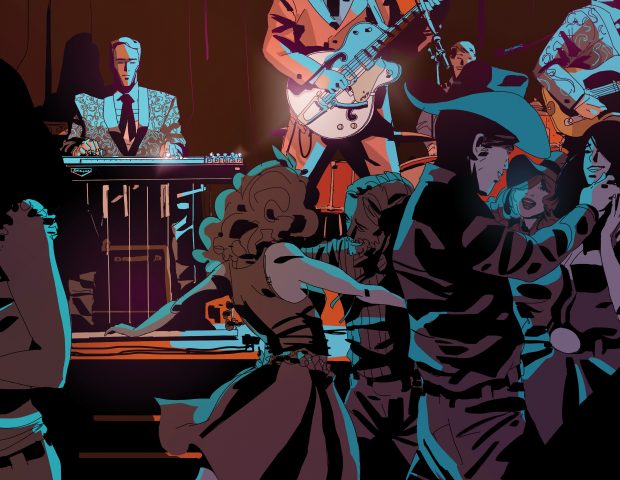
The story is based around the Palomino nightclub, could you tell us a bit about your connection to the Palomino and why you wanted to build a crime comic around it? How important was it for you to get the style and tone of that location right and did you have to do a lot of research to get it looking authentic?
SF: Because of my experience with the clubs’ nightlife, I think its depiction in the book feels lived-in, and brings in a sense of authenticity to the story. Unfortunately, the actual Palomino closed in ‘95, the same year I arrived in LA, so I never got to see it open. But the place still exists as a banquet hall, so I went to visit it, stand on the stage, pace the floor, the parking lot, etc… Just to ingest the spirit of the place. Then I took tons of pictures and built a CG model–both interior and exterior–that I use for reference.
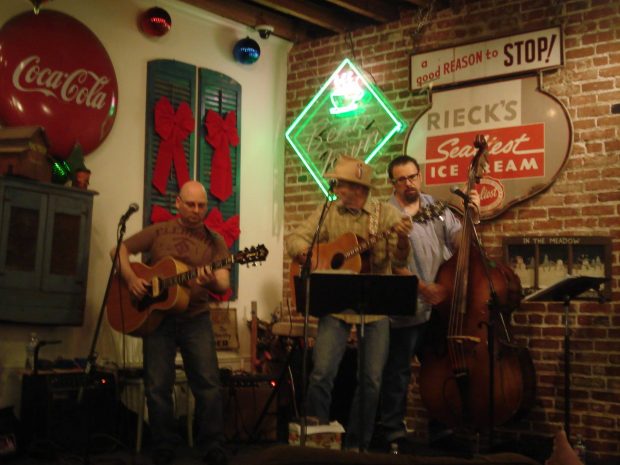
In general, because this book is so specific and everything is in full light, I built CG models of all the main sets, which I then shot with a 2.4:1 anamorphic lens, to recreate the cinematic feel of the time. You’re not really looking at California until you look at it through a movie lens. Then, I took all this reference, and redrew it so that it blends seamlessly with the characters and into the flow of the storytelling, and it disappears into the graphic style of the book.
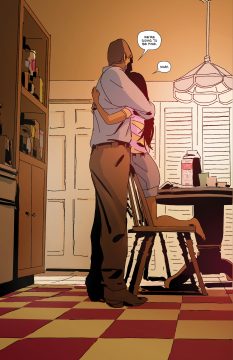 The relationship between Eddie and his daughter feels like a key theme of the series, was it important for you to get that dynamic right? They feel like more than just your usual conflicting parent and teen?
The relationship between Eddie and his daughter feels like a key theme of the series, was it important for you to get that dynamic right? They feel like more than just your usual conflicting parent and teen?
SF: Eddie and Lisette’s relationship was really the breakthrough that prompted my decision to forge ahead with his book. It happened at a time where my youngest kid graduated from college, and joined the ranks of productive and creative adults. That made me want to take a look back at my experience raising children–in LA, but really, anywhere–and to try to examine that relationship. In their case it is a complex mix of several elements. On one hand, Lisette is exactly like Eddie, with a wry sense of humor, an old soul, a badass personality, and a deep sense of empathy, which is also what holds their relationship together. There is an absence of judgement, and the ability to step back sometimes, and not just press every issue like people sometimes do. But most importantly, the family imploded due to a terrible event, and the unresolved nature of that tragedy looms large over their lives. As I used to tell my kids, there are mistakes you learn from, and others from which you never recover. And as a parent, Eddie is trying to find that line.
Your art style feels like it has evolved and developed for this one, have you changed things up in order to get the tone right? The layouts feels much more ambitious with more full pages and spreads than in previous work? Is that to give it all some space and feel more cinematic?
SF: I’m of the school that nothing about art is “decided.” Instead, it is discovered. That’s why from the script, I jump straight into laying out the story and let the designs and style emerge organically from the storytelling process. That is the same way that the great Disney classic characters were designed. They would start with an idea of a character, and let the best animators run with it and animate a minute or two. By letting the characters sort of live their best life that way, the design would evolve and assert itself on its own. So that’s how I work. By the time I’m done laying out the book, I have found what the characters actually look like, which I can then implement as I draw up the actual pages. SILVER was a modern reinvention of the great pulp era adventure strips, mixed with an expressionist, Fritz Lang sort of cinematic feel. That was super fun to do, and from that emerged a certain type of formalism inspired by the newspaper strips. For PALOMINO, it’s all about life in California, with lots of space, lots of openness… In SILVER, things were lurking in the shadows and jumping out of them. In PALOMINO, everything is lit, and all the hiding is taking place inside the characters, through their secrets. The common link between both projects, however, is that I always try to combine the clarity and emotional specificity of film language (which is my native language), with a sense of graphic design that you want in comics, so that each page also has a unique identity, and creates a singular memorable image.

The advent of colour certainly seems to be helping create a unique look and feel for Palomino? Was it a different challenge after the monochrome world of Silver?
SF: Color was definitely the biggest departure in style from SILVER to PALOMINO. I have been doing color for a long time with prints and covers, but I was really looking forward to doing these interiors. Another great thing about coming from animation is that over the years I got to work with amazing art directors, and learned as much as I could from their approach to color. So here too, while the book has an overall comic book esthetic, I think it is also informed by a cinematic approach to color, with an emphasis on contrast and values, as well as following a movie-style “color script” that tracks with the emotions throughout the book. Another fun aspect of color was to try to translate a cinematic vocabulary, such as depth of field, lens flares, etc… through a stylised visual language of colors and shapes that gives you the pleasure of looking at a graphic piece of art. So just like, SILVER did with its black and white and screen tones, I hope that the color in PALOMINO immediately connects with a sense of time and place and gives you a feel for an era, while doing a cool, modern take on it.
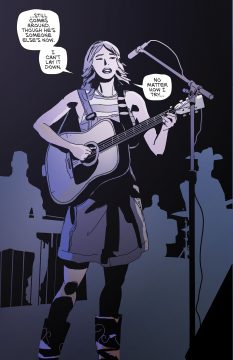
And finally the obvious question, why run a Kickstarter for this during a pandemic? Are there additional challenges to running one at this time, and how do you think comics might evolve and change coming out of this current situation?
SF: While we’re still fully immersed in dealing with Covid right now, I think we are all also concerned about what the “after” looks like. It is obvious that many industries will have been disrupted. The comic book industry is clearly not immune to that. What will it look like next year? I don’t know. The main publishers belong to huge groups, but the core fabric of the industry consists mostly of small and medium size companies, like the thousands of independent comic shops, and the North American printing companies, without whom there is no direct market.
So we want to do everything in our power to help them still exist on the other side of all this. Kickstarter gives readers an opportunity to purchase newly printed books at a time when hardly anything else is open for business, and to keep part of the ecosystem going. Postponing campaigns would only mean cancelling more manufacturing when it doesn’t have to be. In truth, it would be a lot easier to wait things out, but I believe that a sense of productivity and accomplishment, wherever it can be done safely and responsibly, is one more think that will help to see us through.
You can support the Palomino Kickstarter here and find out more about Silver and Stephan’s other indie comics at dark-planet-comics.com or follow Dark Planet Comics on Twitter, Facebook, and Instagram.



September 4, 2025 @ 11:11 pm
Thanks for sharing. I read many of your blog posts, cool, your blog is very good. https://www.binance.com/vi/register?ref=WTOZ531Y
December 19, 2025 @ 10:06 pm
Im Gegensatz zu traditionellen Casinos ermöglichen Online-Plattformen den Spielern, mit virtueller Währung
zu spielen. Wenn Du um die Chance auf den Jackpot spielen willst und das Beste des Jackpot-Spiels erleben möchtest, solltest Du nur die beliebtesten Casinos wählen, die das Vertrauen einer bedeutenden Anzahl von Spielern genießen. Eine Einsatzbedingung
bestimmt, wie oft man den Bonusbetrag durchspielen (Umsatz)
muss. Hunderte von Freispiele bei Mega Moolah,
ohne dass eine Einzahlung erforderlich ist, kann dies ein Versuch
sein, das Glücksspielen bei einem unregulierten Anbieter
zu locken. Wenn Du jedoch anfangen möchtest, um
echtes Geld zu spielen, musst Du Dich registrieren, Dein Konto verifizieren und eine Einzahlung tätigen.
In Online Casinos ist es jedoch möglich, kostenlose DEMO Online
Slots auf dem Computer oder Smartphone zu spielen.
Sowohl die Live-Games als auch die Tischspiele können allerdings nicht im Demomodus kostenlos getestet werden. Im
Energie Kasino stehen auch verschiedene Tischspiele zur Auswahl, die
nicht im Live-Modus gegen den Croupier gespielt werden,
sondern gegen den Computer. Selbstverständlich können die
Energie Kasino Live Tischspiele auch bequem über die mobilen Anwendungen über das Smartphone gespielt werden. Die energiegeladenen Spieler können in diesem Online Casino aus den Vollen schöpfen.
References:
https://online-spielhallen.de/maximale-leon-casino-boni-sichern-dein-ultimativer-code-guide/
December 26, 2025 @ 1:54 pm
We assist with bill resolution options, including insurance negotiations, and payment plans, often reducing charges.
Patient Financial Services advocates for patients, guiding them through the financial process after a flight.
FlyPHI is a mobile and web-based application that supports PHI Air Medical partners by electronically requesting a helicopter.
We safely transport more than 22,500 patients each year, operating out of more than 82 bases across the
United States. And unlike others in the industry, we
have our own fleet so we can guarantee a quality medical flight and exceptional
care across the board. Visit our online patient and family center for
all the resources and assistance you need to get you through this tough time.
Settle a dinner table debate, or practice a new language.
In July 2024, the American Bar Association (ABA) issued its first formal ethics opinion on attorneys using generative
AI. On November 29, Rosário revealed that the bill had been entirely written by ChatGPT, and that he had
presented it to the rest of the council without making any
changes or disclosing the chatbot’s involvement. In Mata
v. Avianca, Inc., a personal injury lawsuit filed in May 2023,
the plaintiff’s attorneys used ChatGPT to generate a legal motion. In November
2025, OpenAI acknowledged that there have been “instances where our 4o model fell short in recognizing signs of delusion or emotional dependency”, and reported that it is working to improve safety.
A 2025 Sentio University survey of 499 LLM users with self-reported mental
health conditions found that 96.2% use ChatGPT, with 48.7% using it specifically for
mental health support or therapy-related purposes.
The integration used ChatGPT to write prompts for DALL-E guided by conversations with users.
In October 2023, OpenAI’s image generation model DALL-E 3 was integrated
into ChatGPT. According to TechCrunch, it is a service based on o3 that combines advanced reasoning and web search capabilities
to make comprehensive reports within 5 to 30 minutes.
At launch, OpenAI included more than 3 million GPTs created by GPT Builder users in the GPT Store.
References:
https://blackcoin.co/best-big-time-gaming-casinos/
December 27, 2025 @ 12:18 am
New players can benefit from informative tutorials and demo rounds to familiarize themselves with the games.
Complete your Ozwin casino login to explore these thrilling games.
With high-quality streaming and interactive gameplay,
players can enjoy an immersive experience right from their homes.
Ozwin casino offers an exciting array of live dealer games
that transport you to an authentic casino setting.
A helpful sorting feature allows you to
organize games by release date, name, or jackpot size. Frequent players already familiar with Ozwin Casino’s
existing offerings will find this section particularly useful.
This gaming platform has gained particular popularity among
Australian users for a multitude of reasons. A significant portion comes from Real
Time Gaming (RTG), a studio with a reputation for delivering high-quality gaming experiences.
Bonus notifications often appear the moment you sign in, or land in your
inbox before you even open a game. Ozwin Casino uses
stable Australian-facing infrastructure, ensuring consistent access across devices,
states, and ISPs. If you’re having trouble logging in from Australia, it’s
usually linked to browser settings, outdated credentials,
or rare connectivity issues — not platform failure.
References:
https://blackcoin.co/paypal-casinos-top-online-casinos-for-paypal-deposits-and-withdrawals/
December 29, 2025 @ 5:34 am
paypal casino online
References:
hyojun.co.kr
December 29, 2025 @ 6:00 am
online casino paypal
References:
https://www.konqisakaxgy.shop/bbs/board.php?bo_table=free&wr_id=198